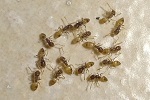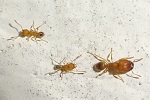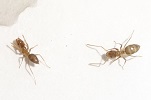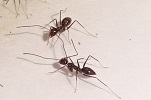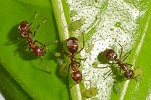| Home | Nature Weekly Index |
30 August 2015 | House Ants |
Ants are an integral part of urban living in Singapore. Though they are tiny, you are never going to get rid of them, no matter how hard you try. As long as there is food around, they will come, and they can appear really fast from nowhere. Over time, I had recorded the resident ants at my home, mainly along the balcony area. The size of the contingent of the different ant species do fluctuate over time.
Besides the 6 shown above, there is another mid-size but illusive ant, Bicoloured Pennant Ant (Tetramorium bicarinatum). I have not seen it for some months now. The Cocoa Black Ant (Dolichoderus thoracicus) on the far right above is not exactly an ant that roam around apartment blocks. It is a dweller in wild parks but came to my place due to the plants growing along my balcony, likely from a flying queen ant that landed in my pot. It was first seen on the plants along the balcony in June this year.
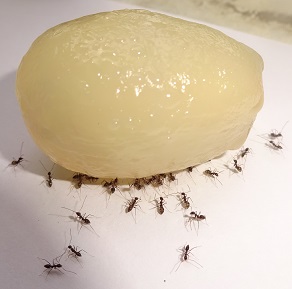 In the early part of the month, I did an ant baiting exercise along my balcony and corridor areas using
Rambutan fruits (Nephelium lappaceum). The aim was simply to see what type
of ants come along and to take some good pictures of them. Four fruits were placed at different locations. The first ant that
detected the fruits within minutes was the
Black Crazy Ant (Paratrechina longicornis).
Eventually, two of the fruits were taken by a
tiny red ant (Pheidole parva), one by the Black Crazy Ant and the
last one by another black ant (Nylanderia species), that looked
like the Black Crazy Ant. Based on the observation, it is quite clear that an ant species will not share their loot with another
ant species. Also, the ability to defend the ownership of a loot is not dependent on the size of the ant --- the much larger Black
Crazy Ant was apparently no match to the smaller red ant.
In the early part of the month, I did an ant baiting exercise along my balcony and corridor areas using
Rambutan fruits (Nephelium lappaceum). The aim was simply to see what type
of ants come along and to take some good pictures of them. Four fruits were placed at different locations. The first ant that
detected the fruits within minutes was the
Black Crazy Ant (Paratrechina longicornis).
Eventually, two of the fruits were taken by a
tiny red ant (Pheidole parva), one by the Black Crazy Ant and the
last one by another black ant (Nylanderia species), that looked
like the Black Crazy Ant. Based on the observation, it is quite clear that an ant species will not share their loot with another
ant species. Also, the ability to defend the ownership of a loot is not dependent on the size of the ant --- the much larger Black
Crazy Ant was apparently no match to the smaller red ant.
For quite a while, I had thought that the black ant was Argentine Ant (Linepithema humile) until I read an article this month on the ants found in healthcare facilities in Singapore published in 2012. The article listed 18 ant species but the Argentine Ant was not part of the list. Since this ant is found in my home, it is expected to be available around healthcare facilities as well. After further investigation, I landed on a more probable name Nylanderia species. The number of this particular ant had started to decline drastically over the last few months, likely due to competition from other ant species.
Of the 6 ant species, the population of the Black Crazy Ant and the tiny red ant appeared to be increasing while the Cocoa Black Ant, the most aggressive-looking of the lots, is sort of stable. It is kind of fun to observe the dynamic of the ant population and interaction at the comfort of my home.
On a separate note, I have uploaded my collection of snail pictures yesterday.
